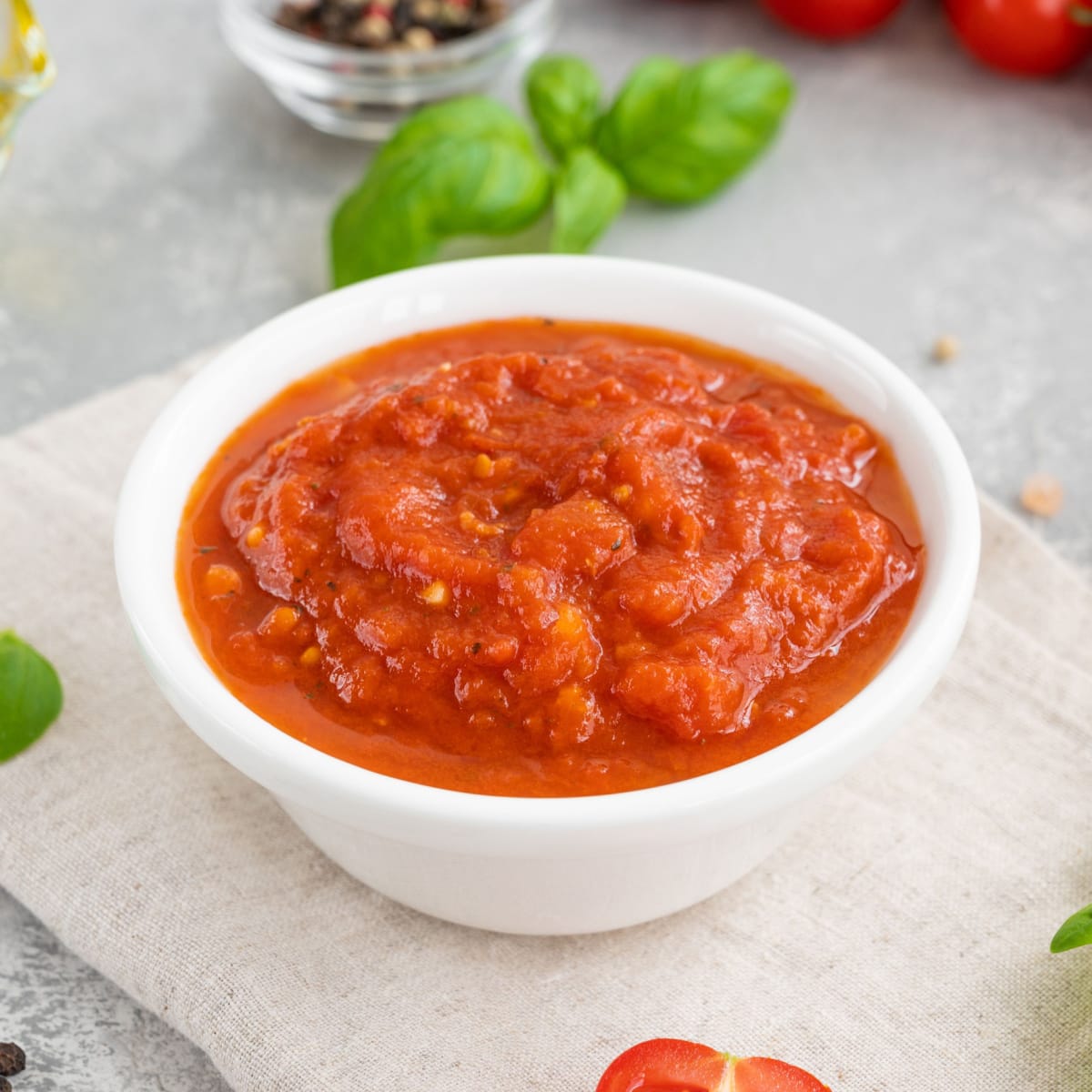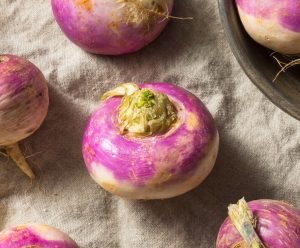The difference between marinara and pasta sauce is simple. Marinara sauce is a simple Italian tomato sauce made with tomatoes, garlic, herbs, and olive oil.
Pasta sauce is a broader term and applies to a variety of sauce options. It often features additional ingredients like meat, vegetables, spices, and sometimes cream or cheese. Pasta sauce is thicker and richer in flavor, offering more versatility in recipes.

However, marinara and pasta sauce look a lot alike. So it’s not surprising these two stir up quite the confusion.
If you find the difference perplexing, worry not. From the ingredients to the uses, you’ll learn all about marinara vs. pasta sauce.
So grab your apron and let’s get saucy!
Marinara vs. Pasta Sauce (What’s the Difference?)
If you’re going by looks, it’s nearly impossible to tell marinara and pasta sauce apart. They look virtually the same!
But when you compare the flavors and textures, the differences become clearer. Let’s delve deeper into what sets them apart.
Ingredients
How different can they be? After all, both are tomato-based sauces. The answer is, more than you think!
Marinara has tomatoes, garlic cloves, olive oil, and herbs. There are many variations, but they usually include a combination of these four primary ingredients.
This is a sauce for purists who like to keep their Italian meals simple and fuss-free.
Pasta sauce ingredients, however, have a lot more variability. The name itself is more of an umbrella term for many different things.
Technically, if it’s a sauce and it’s on pasta, then it’s pasta sauce. Alfredo, pesto, Fra Diavolo, and Arrabbiata sauce are just some examples.
However, many people use the term “pasta sauce” as slang for red sauce. In this sense, pasta sauce has tomatoes, onions, garlic, herbs, and spices.
The tomatoes themselves may vary. Crushed or pureed canned tomatoes, tomato paste, and passata are all common.
Texture
Like the ingredients, the texture of these sauces is different, too.
Marinara is thin and light with a uniform consistency. Its rustic counterpart is noticeably different.
Pasta sauce is thicker and chunkier. It has a more robust mouthfeel that’s excellent for hearty meals.
Flavor
You don’t need a well-trained palate to taste the difference. Once you know the ingredients, the flavors really start to jump out at you.
Pasta sauce is bold, robust, and complex. Depending on the recipes, you may pick up on various herbs and spices.
Marinara sauce is more delicate and tomato-forward with less complexity. It’s a fine choice for pasta when you don’t want to overwhelm it with sauce.
Cooking Time
Marinara sauce takes about 30 minutes to prepare.
Some recipes take longer and others are much shorter. The overall cooking time will vary by recipe. But it’s typically shorter than pasta sauce.
Speaking of which, pasta sauce takes longer to cook. It has more ingredients and sometimes includes meat. Some recipes require 2 hours of cooking! Like marinara, however, the cooking time will vary.
Uses
Both sauces are excellent with pasta. But what type of pasta dish should you pair them with?
Marinara is great for anything with seafood, like mussels and clams. The light flavor won’t mask the protein.
You can also use it as a pizza sauce or as a dipping sauce. (Like for cheesy mozzarella sticks!)
Pasta sauce is best for hearty, meaty pasta dishes. Use it as a sauce for spaghetti and meatballs or baked pasta like ziti.

What Is Marinara?
Marinara is a tomato-based Italian sauce. It’s made with four key ingredients: tomatoes, fresh garlic, olive oil, and herbs.
Like most recipes, the ingredients can vary. Basil, oregano, anchovies, capers, olives, and tomato paste are other things included.
Traditionally, marinara is very tomato-forward. It’s thin, light, uncomplicated, and great for more delicate pasta dishes.
Marinara also makes for one mean dipping sauce. So bust out those breadsticks and dig in!
Is Marinara the Same As Tomato Sauce?
They look an awful lot alike. But marinara is not the same as tomato sauce.
Marinara sauce is a simple red sauce and uses minimal ingredients. It’s thin and consistent in texture, letting the tomato flavor shine.
Tomato sauce doesn’t always have the same ingredients. Plain tomato sauce is essentially just tomatoes. They get cooked down until some liquid evaporates.
Sometimes, it may include other spices, herbs, and ingredients like garlic or onion.

What Is Pasta Sauce?
Pasta sauce can be any type of sauce you put on pasta. So the options are practically endless.
Typically, the term is referencing a general tomato-based sauce. The ingredients usually include tomatoes, onions, garlic, herbs, and spices.
The tomatoes themselves can vary. They can be passata, paste, canned, or fresh tomatoes.
It’s thick, complex, and heartier than marinara. So pasta sauce is better for meaty pasta dishes and cheesy bakes. In fact, meat is often a common ingredient in the sauce.
How to Thicken Marinara and Pasta Sauce
Is your marinara or pasta sauce too thin? Don’t fret!
There are some simple solutions to thicken your sauce. Here are the top methods to try:
- Simmer it without the lid. Letting the sauce cook longer without a lid will let more moisture evaporate.
- Stir in a slurry. Making a slurry with cornstarch or flour does the trick. You can mix a ratio of 1:1 flour to water. Or use a ratio of 1:4 cornstarch to water. Then, stir it in.
- Add tomato paste. Tomato paste is thick and concentrated. Add a spoonful or two and give it a good stir.
- Use a roux. A roux is equal parts flour to fat. Mix melted butter with flour in a pan, then stir it into the sauce.
Flavor Boosters
Looking to give your marinara and pasta sauce a boost? I have just the thing!
From herbs to spices, you can add many things to make your sauce tastier. Here are some recommendations:
- Add sugar. It will help balance the acidity of the sauce.
- Make it spicy. A pinch of red chili pepper flakes or cayenne will kick up the heat.
- Pour in a glug of red wine. This is a simple trick to increase complexity.
- Make it hearty with meat. Ground turkey, beef, or sausage make the sauce more savory.
- Add cheese. Parmesan, mozzarella, Asiago, and Pecorino Romano are all nice additions.
- Try different herbs. Bay leaf, oregano, basil, and other Italian herbs will be complementary.

Can You Substitute Marinara for Pasta Sauce and Vice Versa?
Yes, you can substitute the two.
For many red sauce-based dishes, marinara and pasta sauce are interchangeable. Think al dente angel hair pasta, gnocchi, or tortellini.
Remember, these sauces are different. So swapping them will change the flavor, but not too drastically.
However, for other sauces like pesto or Alfredo, pasta sauce is not as interchangeable.
Consider your dish and the overall flavor. If it calls for a tomato-based sauce, either can work.










